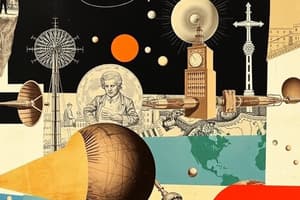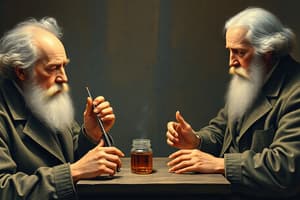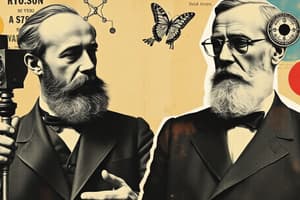Podcast
Questions and Answers
What significant discovery did Wilhelm Conrad Röntgen make that contributed to physics and medicine?
What significant discovery did Wilhelm Conrad Röntgen make that contributed to physics and medicine?
- Radioactive decay
- Gravitational waves
- X-rays (correct)
- Electron configuration
Which concept is central to Ivan Pavlov's research on digestive secretions in dogs?
Which concept is central to Ivan Pavlov's research on digestive secretions in dogs?
- Operant conditioning
- Observational learning
- Classical conditioning (correct)
- Cognitive dissonance
Kitasato Shibasaburo is known for developing a therapy to protect against which two diseases?
Kitasato Shibasaburo is known for developing a therapy to protect against which two diseases?
- Tetanus and diphtheria (correct)
- Measles and mumps
- Tuberculosis and pneumonia
- Influenza and smallpox
J. J. Thomson made a groundbreaking discovery using a cathode ray tube involving the structure of atoms. What did he identify?
J. J. Thomson made a groundbreaking discovery using a cathode ray tube involving the structure of atoms. What did he identify?
What climatic theory did Svante Arrhenius propose linked to volcanic eruptions?
What climatic theory did Svante Arrhenius propose linked to volcanic eruptions?
Annie Jump Cannon's notable work involved classifying what astronomical features?
Annie Jump Cannon's notable work involved classifying what astronomical features?
Henrietta Swan Leavitt's work with Cepheid variable stars was crucial for what astronomical measurement?
Henrietta Swan Leavitt's work with Cepheid variable stars was crucial for what astronomical measurement?
What key transformation did Harriet Brooks discover about elements?
What key transformation did Harriet Brooks discover about elements?
How did Srinivasa Ramanujan initially catch the attention of the mathematical community in Cambridge?
How did Srinivasa Ramanujan initially catch the attention of the mathematical community in Cambridge?
Erwin Schrödinger contributed significantly to quantum mechanics through the development of what concept?
Erwin Schrödinger contributed significantly to quantum mechanics through the development of what concept?
Flashcards
X-rays
X-rays
Electromagnetic rays discovered by Wilhelm Röntgen that penetrate human skin.
Classical Conditioning
Classical Conditioning
Learning process where dogs associated a bell with food, researched by Ivan Pavlov.
Serum Therapy
Serum Therapy
Developed by Kitasato Shibasaburo to protect against tetanus and diphtheria using antitoxins.
Plum Pudding Model
Plum Pudding Model
Signup and view all the flashcards
Climate Change Link
Climate Change Link
Signup and view all the flashcards
Harvard Spectral Classification
Harvard Spectral Classification
Signup and view all the flashcards
Cepheid Variable Stars
Cepheid Variable Stars
Signup and view all the flashcards
Nuclear Decay
Nuclear Decay
Signup and view all the flashcards
Schrödinger Equation
Schrödinger Equation
Signup and view all the flashcards
Miller-Urey Experiment
Miller-Urey Experiment
Signup and view all the flashcards
Study Notes
Science in the 19th and 20th Centuries
- Science progressed greatly in the 19th and 20th centuries, with crucial shifts in fundamental ideas at both subatomic and cosmological levels.
- Cutting-edge research fueled groundbreaking discoveries.
Wilhelm Conrad Röntgen
- German physicist who discovered X-rays in 1895.
- Used electrically charged vacuum tubes to produce X-rays.
- X-rays enabled medical imaging and diagnostics.
- Awarded the first Nobel Prize in Physics in 1901.
Ivan Pavlov
- Russian-born physiologist, renowned for classical conditioning.
- Research on digestive secretions of dogs.
- Dogs learned to associate a bell with food, leading to salivation even without food.
- Awarded the Nobel Prize in Physiology or Medicine for this work.
Kitasato Shibasaburo
- Japanese physician and bacteriologist.
- Discovered antitoxins for tetanus and diphtheria.
- Invented serum therapy to treat tetanus and diphtheria.
- Developed the principle of immunization against infectious diseases.
Jules Henri Poincaré
- French mathematician and physicist noted for his work on chaos theory.
- His findings on chaos, published as early as 1908, were later considered fundamental in chaos theory.
- Also contributed to work related to electromagnetism and relativity.
J.J. Thomson
- English physicist, early scientist to study atomic structure.
- Identified "corpuscles", later named electrons, through cathode ray tube experiments.
- Developed the "plum pudding" model of the atom.
- Proposed that atoms have a positively charged "pudding" with negatively charged electrons embedded within.
- Identified isotopes of elements.
Svante Arrhenius
- Swedish physicist who studied physics at Uppsala University.
- Became a professor of physics at Stockholm University.
- Proposed a link between fossil fuel burning and rising global temperatures.
- Noted that reducing greenhouse gases could cool down Earth.
- Hypothesized that past ice ages could be attributed to variations in volcanic activity, influencing gases in the atmosphere.
Annie Jump Cannon
- Leading authority of 20th-century astronomy on star spectra.
- Studied at Wellesley College and Harvard College Observatory.
- Developed the Harvard Spectral Classification System, which used photographic plates to classify stars based on their luminosity.
- Classified over 350,000 stars.
Henrietta Swan Leavitt
- American astronomer.
- Analyzed Cepheid variable stars and their luminosity.
- Discovered a relationship between the period of Cepheid variable stars and their intrinsic luminosity, crucial for determining the distances to galaxies.
- Provided a crucial tool for measuring cosmic distances in the universe.
Harriet Brooks
- Canadian nuclear physicist, one of the first female nuclear physicists.
- Conducted pioneering research on radioactivity and nuclear decay.
- Worked in Marie Curie's lab.
- Developed a standard for photographic measurements (Harvard Standard).
- Developed a standard for photographic measurements.
Srinivasa Ramanujan
- Indian mathematician, well-known for his contributions to mathematical analysis and number theory.
- Had minimal formal training, but independently made significant discoveries.
- Sent a letter containing 120 theorems to G.H. Hardy, leading to his recognition and work at Cambridge University.
Erwin Schrödinger
- Austrian theoretical physicist best known for his work on quantum mechanics.
- Developed the Schrödinger equation, a fundamental equation of quantum mechanics, allowing prediction of electron behavior within atoms.
- Proposed a probabilistic model of electron behavior.
Ronald Fisher
- British statistician.
- Pioneered the application of statistics to scientific experiments.
- Successfully reconciled Charles Darwin's theory of natural selection with Gregor Mendel's experiments, strengthening the modern synthesis of evolutionary biology.
Harold Urey and Stanley Miller
- American chemists who conducted the Miller-Urey experiment.
- Simulated early Earth's conditions in the lab.
- Showed that organic compounds could be formed from inorganic matter under early Earth conditions.
- Their work provided evidence that life could have arisen on Earth from simple chemical processes, potentially paving the way to understand how life started.
Studying That Suits You
Use AI to generate personalized quizzes and flashcards to suit your learning preferences.





